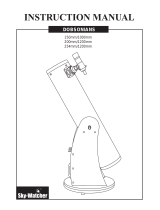
- 19 -
DE
Die reguläre Garantiezeit beträgt 2 Jahre
und beginnt am Tag des Kaufs. Um von einer
verlängerten, freiwilligen Garantiezeit wie auf
dem Geschenkkarton angegeben zu profitieren,
ist eine Registrierung auf unserer Website
erforderlich.
Die vollständigen Garantiebedingungen sowie
Informationen zu Garantiezeitverlängerung
und Serviceleistungen können Sie unter www.
bresser.de/garantiebedingungen einsehen.
Sie wünschen eine ausführliche Anleitung zu
diesem Produkt in einer bestimmten Sprache?
Dann besuchen Sie unsere Website über
nachfolgenden Link (QR Code) für verfügbare
Versionen.
Alternativ können Sie uns auch eine E-Mail an
die Adresse manuals@bresser.de schicken
oder eine Nachricht unter +49 (0) 28 72 – 80
74-220* hinterlassen. Bitte geben Sie stets
Ihren Namen, Ihre genaue Adresse, eine gültige
Telefonnummer und E-Mail-Adresse sowie die
Artikelnummer und -bezeichnung an.
* Lokale Rufnummer in Deutschland (Die Höhe der Gebühren
je Telefonat ist abhängig vom Tarif Ihres Telefonanbieters);
Anrufe aus dem Ausland sind mit höheren Kosten verbunden.
GB
The regular guarantee period is 2 years and
begins on the day of purchase. To benefit
from an extended voluntary guarantee period
as stated on the gift box, registration on our
website is required.
You can consult the full guarantee terms
as well as information on extending the
guarantee period and details of our services at
www.bresser.de/warranty_terms.
Would you like detailed instructions for this
product in a particular language? Then visit
our website via the link below (QR code) for
available versions.
Alternatively you can also send an email to
manuals@bresser.de or leave a message on
+49 (0) 28 72 – 80 74-220*. Please always
state your name, precise address, a valid phone
number and email address, as well as the article
number and name.
* Number charged at local rates in Germany (the amount you
will be charged per phone call will depend on the tariff of your
phone provider); calls from abroad will involve higher costs.
FR
La durée normale de la garantie est de 2 ans
à compter du jour de l’achat. Afin de pouvoir
profiter d’une prolongation facultative de la
garantie, comme il est indiqué sur le carton
d’emballage, vous devez vous enregistrer sur
notre site Internet.
Vous pouvez consulter l’intégralité des
conditions de garantie ainsi que les
informations concernant la prolongation de
la garantie et les prestations de service sur
www.bresser.de/warranty_terms.
Vous souhaitez un mode d’emploi détaillé
pour ce produit dans une langue spécifique ?
Alors consultez notre site Internet à l’aide du
lien suivant (code QR) pour voir les versions
disponibles.
Vous pouvez également nous envoyer
un e-mail à l’adresse manuals@bresser.
de ou nous laisser un message au
+49 (0) 28 72 – 80 74-220*. Indiquez
toujours votre nom, votre adresse exacte, un
numéro de téléphone et une adresse e-mail
valides ainsi que le numéro de l’article et sa
description.
* Numéro d’appel local en Allemagne (le montant des frais
par appel téléphonique dépend du tarif de votre opérateur
téléphonique) ; les appels depuis l’étranger entrainent des
coûts plus élevés.
NL
De reguliere garantieperiode bedraagt 2
jaar en begint op de dag van aankoop. Om
gebruik te maken van een verlengde vrijwillige
garantieperiode zoals aangegeven op de
geschenkverpakking is aangegeven dient het
product op onze website geregistreerd te
worden.
De volledige garantievoorwaarden en
informatie over de verlenging van de
garantieperiode en servicediensten kunt u
bekijken op www.bresser.de/warranty_terms.
U wenst een uitvoerige gebruikshandleiding
voor dit product in een specifieke taal? Bezoek
dan onze website via deze link (QR Code) voor
alle beschikbare versies.
U kunt ook een e-mail sturen naar
manuals@bresser.de of een bericht
achterlaten op nummer +49 (0) 28 72 – 80
74-220*. Vermeld alstublieft altijd uw naam,
uw exacte adres, een geldig telefoonnummer
en e-mailadres, evenals het artikelnummer en
het kenmerk.
* Lokaal nummer in Duitsland (het tarief voor het
telefoongesprek is afhankelijk van het tarief van uw
telefoonprovider). Telefoongesprekken uit het buitenland
brengen hogere kosten met zich mee.
IT
La durata regolare della garanzia è di 2 anni e
decorre dalla data dell'acquisto. Per godere di
un'estensione volontaria della garanzia come
descritto sulla confezione regalo, è necessario
registrarsi nel nostro sito Web.
Le condizioni complete di garanzia e le
informazioni sull'estensione di garanzia e
i servizi di assistenza sono visibili al sito
www.bresser.de/warranty_terms.
Desidera ricevere informazioni esaustive su
questo prodotto in una lingua specifica? Venga
a visitare il nostro sito Web al seguente link
(codice QR Code) per conoscere le versioni
disponibili.
ES
El período regular de garantía es dos anos
iniciándose en el día de la compra. Para
beneficiarse de un período de garantía más
largo y voluntario tal y como se indica en la
caja de regalo es necesario registrarse en
nuestra página web.
Las condiciones de garantía completas
así como informaciones relativas
a la ampliación de la garantía y los
servicios pueden encontrarse en
www.bresser.de/warranty_terms
¿Desearía recibir unas instrucciones de uso
completas sobre este producto en un idioma
determinado? Entonces visite nuestra página
web utilizando el siguiente enlace (código
QR) para ver las versiones disponibles.
O envíenos un mensaje a la dirección de
correo manuals@bresser.de o déjenos un
mensaje telefónico en el siguiente número
+49 (0) 28 72 – 80 74-220*. Asegúrese de
dejar su nombre, dirección, teléfono válido,
una dirección de correo electrónico así como
el número del artículo y su descripción.
* Número local de Alemania (el importe de cada llamada
telefónica dependen de las tarifas de los distribuidores);
Las llamadas des del extranjero están ligadas a costes
suplementarios.
RU
Стандартный гарантийный срок составляет
2 года, начиная со дня покупки. Чтобы
воспользоваться расширенной гарантией,
необходимо зарегистрироваться на нашем
сайте.
Подробные условия гарантии, информацию о
расширенной гарантии и о наших сервисных
центрах можно получить на нашем сайте
www.bresser.de/warranty_terms.
Вам требуется подробная инструкция на
это изделие на определенном языке?
Проверьте наличие соответствующей
версии инструкции, посетив наш сайт по этой
ссылке (QR-код).
www.bresser.de/download/Messier/Dobson
Garantie & Service · Warranty and Service ·
Garantie et Service · Garanzia e assistenza
Garantía y servicio ·
Гарантия и обслуживание
IX





















